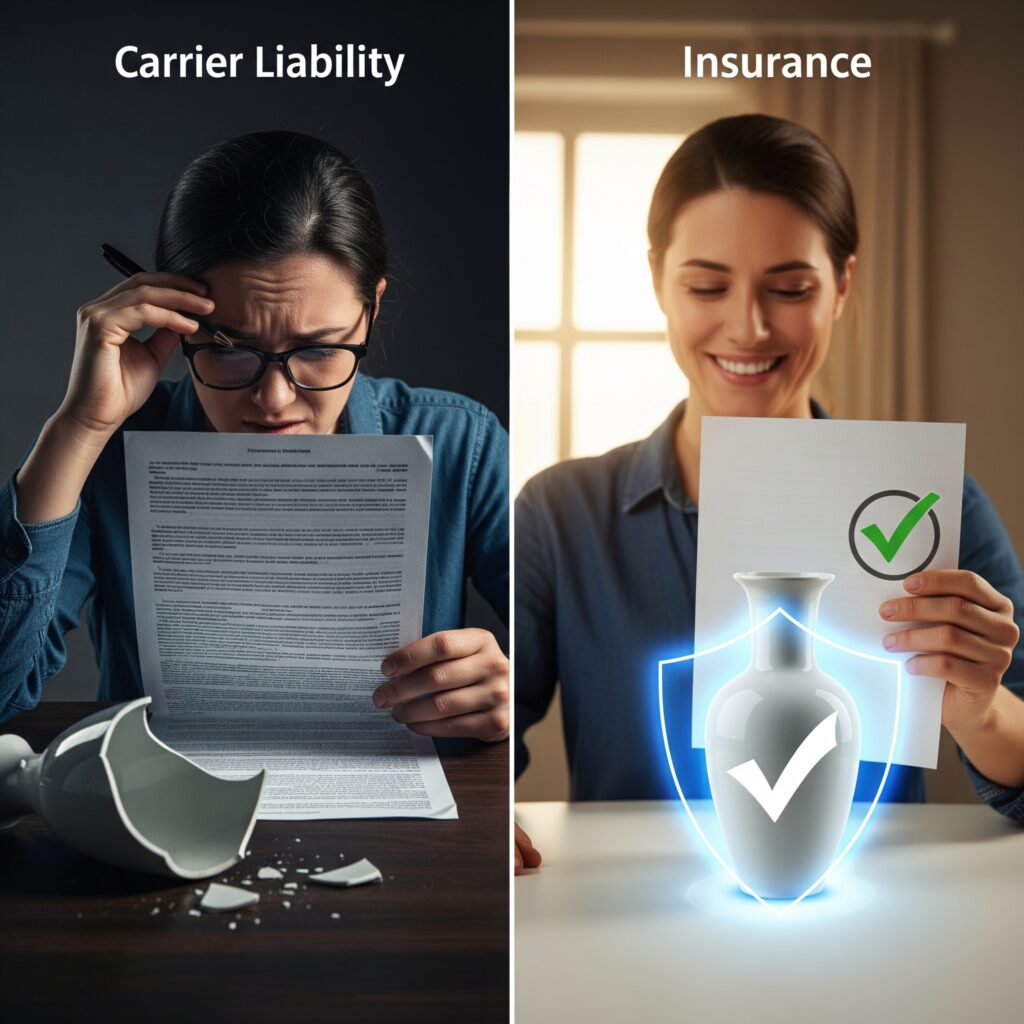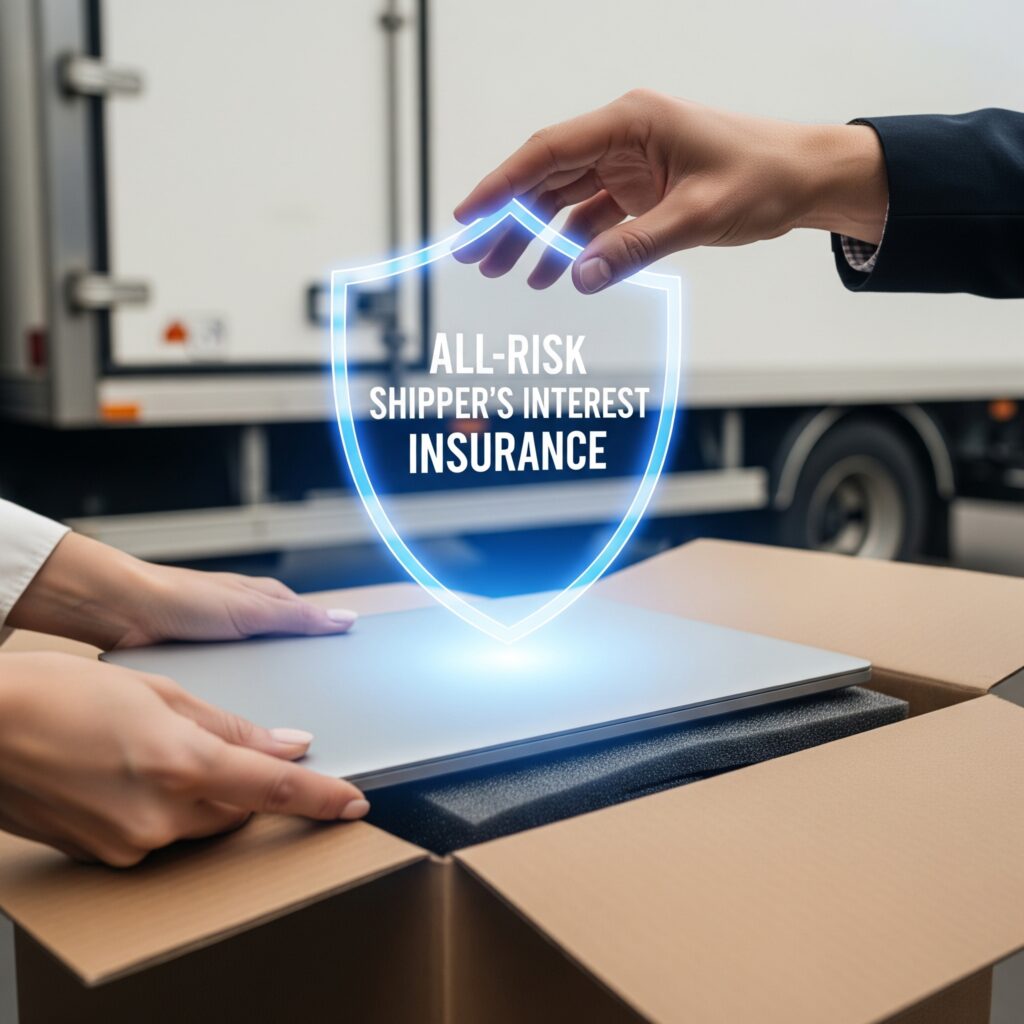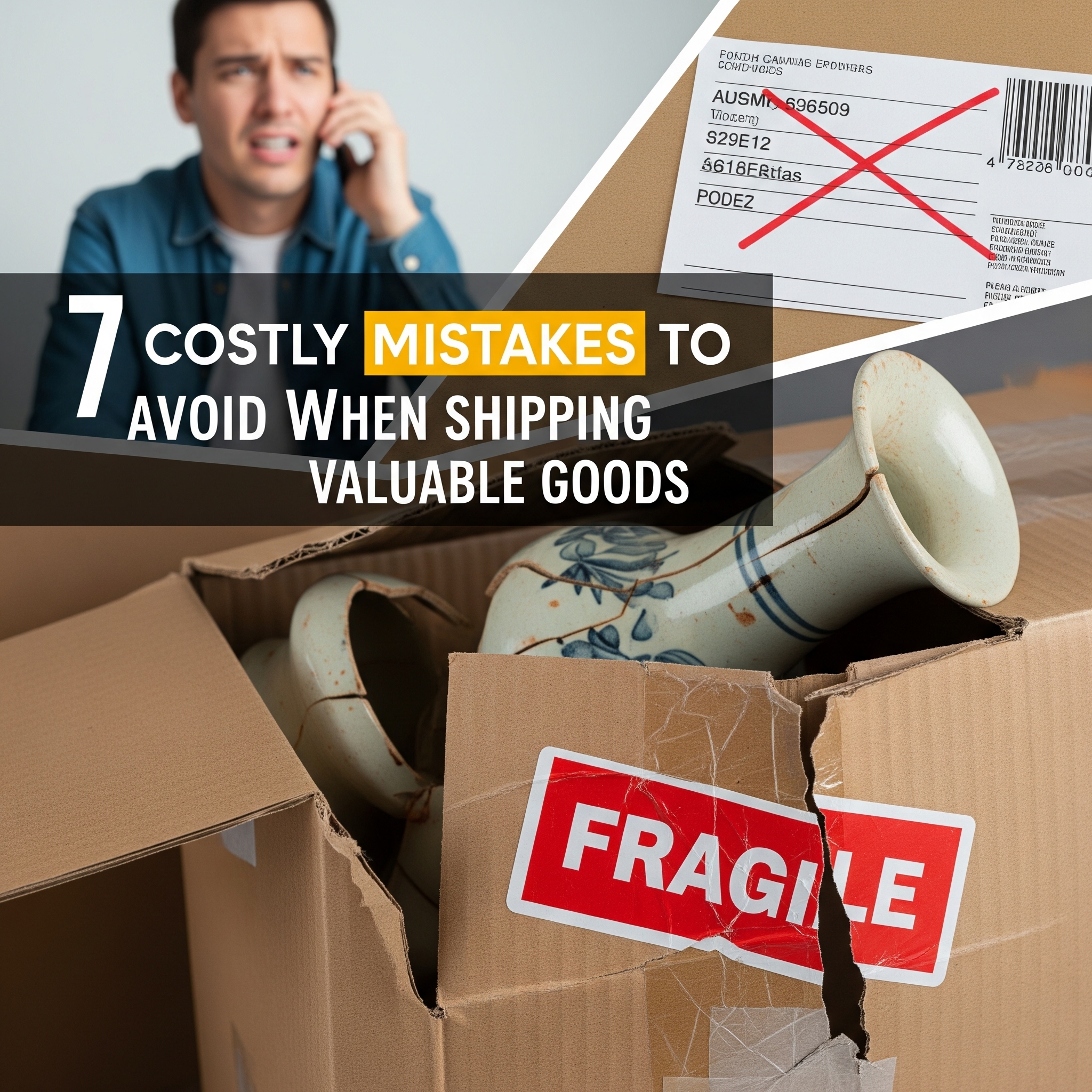Shipping Valuable Goods: Understanding Your True Financial Exposure
As a business owner or manager, you understand the importance of diligence. When it’s time to ship a high-value item – a custom-machined part, a sensitive piece of medical equipment, a pallet of high-end electronics, or a piece of fine art – you take every precaution. You source the sturdiest boxes, invest in premium packing materials, and carefully prepare the item for its journey. As the courier picks it up, you feel a sense of relief, confident that you’ve done everything possible to ensure a safe delivery.
But what if the most significant risk to your business isn’t a cracked screen or a dented corner? What if it’s a financial blind spot – a dangerous misconception about what happens if your shipment is lost, stolen, or damaged beyond repair?
The truth is, the vast majority of businesses are unknowingly exposed to catastrophic financial loss every single day. They rely on a system they believe is insurance but is, in fact, something entirely different. This guide is designed to illuminate this hidden risk. We will uncover the seven most common and costly mistakes businesses make when shipping valuable goods and reveal the foundational principles of true shipment protection.
The first step in effective risk management is understanding the nature of the risk itself. When it comes to shipping valuable goods, the risk is not merely the potential for physical damage, but the vast and often shocking gap between the actual value of your item and the amount a carrier is legally obligated to reimburse you for in the event of a loss. Bridging this financial exposure gap is the single most important aspect of any strategy for shipping valuable goods safely and sustainably. Without addressing it, even the best packaging in the world is simply protecting an asset that you may never be financially compensated for.
The Journey of a Package: A Gauntlet of Unseen Risks
Before we delve into the financial mistakes, it’s crucial to understand the physical journey. Why is shipping valuable goods so inherently risky? Because the modern logistics network is a marvel of automated efficiency built for speed and volume, not for delicate, individual care.

The Automated Chaos of the Sorting Hub
Your package arrives at a massive sorting facility, a warehouse humming with miles of high-speed conveyor belts, automated scanners, and powerful mechanical diverters. It will be sent down chutes, colliding with other packages, and sorted into large containers where it can be crushed under the weight of hundreds of pounds of other goods. This environment is the source of most kinetic shock and impact damage, much of which can be concealed from the outside.
The Environmental Stresses of Long-Haul Transit
Once sorted, your package is loaded onto a truck or plane for the longest part of its journey. This stage introduces severe environmental risks. The cargo hold of an airplane can reach near-freezing temperatures, potentially destroying sensitive electronics or freezing liquids. The back of a semi-trailer can become an oven in the summer, warping plastics and degrading components. Throughout this entire process, the shipment is subjected to a constant, low-frequency vibration that can loosen connections and weaken solder joints, a silent killer for any complex item. Proper risk management for shipping valuable goods must account for these non-obvious threats.
The Human Element: From Negligence to Theft
Finally, the journey involves numerous human touchpoints, each a potential point of failure. A tired worker might accidentally drop your package. A rushed delivery driver might leave it on a public-facing doorstep, making it an easy target for porch pirates who specifically look for boxes that appear to contain high-value items. The challenges involved in shipping valuable goods extend right up to the recipient’s front door.
The Great Misconception: Unpacking the Carrier Liability Myth
Understanding the physical risks is essential because it provides the context for the financial risks. The damage that occurs on this journey is precisely what you expect to be covered for. The following mistakes are rooted in the misunderstanding of what “carrier coverage” actually is.

Mistake #1: Believing “Basic Coverage” is Insurance
This is the foundational error from which all others stem. The “coverage” automatically included by a carrier is not insurance. It is called Limited Liability. This is a legal concept, not a service. Its purpose is to limit the carrier’s financial responsibility in the event they are found negligent for damaging or losing your shipment.
Think of it this way: insurance is a product you buy to transfer your risk to a third party. The insurance company’s goal is to make you whole after a loss. Carrier liability, on the other hand, is a legal term in the carrier’s contract designed to protect them from the full value of your loss. Their goal is to minimize their own payout. The entity paying the claim – the carrier itself – is the same entity that caused the loss, creating a clear conflict of interest. This is a critical distinction to grasp when shipping valuable goods.
Mistake #2: Ignoring the “$2/lb Rule” (Coverage Limits)
Because carrier liability is not insurance, it does not pay out based on the item’s value. It pays out based on a predetermined formula, which for most ground shipments in North America is a shockingly low $2.00 per pound.
Let’s illustrate how devastating this can be for businesses shipping valuable goods.
| Item Shipped | Actual Value | Approx. Weight | Carrier Liability Payout ($2/lb) | Your Financial Loss |
| Custom Automotive Part | $4,500 | 40 lbs | $80.00 | $4,420.00 |
| High-End Graphics Card | $2,200 | 4 lbs | $8.00 | $2,192.00 |
| Designer Wedding Dress | $8,000 | 10 lbs | $20.00 | $7,980.00 |
| Medical Diagnostic Tool | $25,000 | 15 lbs | $30.00 | $24,970.00 |
| Piece of Original Art | $12,000 | 25 lbs | $50.00 | $11,950.00 |
The numbers are staggering. In every scenario, the business is left absorbing more than 99% of the loss. For a small business, a single incident like this could be an existential threat. This is the hidden reality of shipping valuable goods under the default terms.
Mistake #3: Paying for “Declared Value” and Thinking You’re Insured
This is the most common trap. A carrier will allow you to “declare a value” for your shipment for an extra fee. This feels like buying insurance, but it is not. You are simply paying a fee to increase the carrier’s maximum limit of liability.
Critically, it does not change the terms of that liability. You still must go through their arduous claims process and, most importantly, you still bear the burden of proving that the loss or damage was the direct result of their specific negligence. If damage was caused by vibration or an “Act of God,” your claim will likely be denied even if you paid for a higher declared value. It’s an illusion of safety that offers only marginally better protection than the default.
Mistake #4: Underestimating the Claims Gauntlet
Let’s say you decide to file a claim. You are now entering the “claims gauntlet,” a process that is often slow, complex, and adversarial. When shipping valuable goods, you need a claims process that is fast and simple, but the carrier system is the opposite. You will be asked to provide a mountain of documentation—original invoices, detailed photos of the packaging and damage, signed statements, and more. The investigation can take weeks, or more often, months. During this time, your cash flow is impacted, and your customer is left waiting. Any missing document or procedural misstep can be used as grounds to deny your claim entirely.
Mistake #5: Forgetting About Hidden Deductibles
Even if you navigate the claims gauntlet successfully, some carrier liability policies for higher-value goods come with a deductible. This means that even after your claim is approved, the first portion of the loss, sometimes hundreds of dollars, is deducted from your final payout, leaving you with yet another unexpected financial shortfall.
Mistake #6: Misunderstanding the Burden of Proof
This is the legal linchpin of the carrier liability model. To get paid, you must prove that the carrier’s specific actions or negligence caused the damage. This is often impossible. How can you prove that constant, low-level vibration on their truck caused a hidden electronic component to fail? How can you prove a package was left in the rain on a loading dock overnight? Without video evidence, you can’t. This impossibly high burden of proof is why so many legitimate claims are denied when shipping valuable goods.
Mistake #7: Not Knowing a Better Option Exists
The most costly mistake of all is simply accepting this flawed system as the only option. Many businesses absorb the cost of lost and damaged goods as a “cost of doing business” because they are unaware that a fundamentally different and superior solution exists. This is where we transition from understanding the problem to discovering the solution.
Beyond Liability: The Professional Approach to Risk Transfer
Now that we’ve thoroughly established the problems with the default system, it’s time to introduce the professional solution. This involves shifting your mindset from accepting liability to proactively transferring risk.

What is “Shipper’s Interest” Insurance?
True shipment protection is a formal insurance product, often called “Shipper’s Interest” insurance. The name says it all: this policy is designed to protect the shipper’s interest, not the carrier’s. It is offered by a third-party insurance company, completely separate from the carrier. This removes the inherent conflict of interest in the claims process. The insurer’s business is to pay legitimate claims quickly and fairly according to the policy terms.
The Power of “All-Risk” Coverage
The best form of Shipper’s Interest insurance is an “All-Risk” policy. This is the gold standard for shipping valuable goods. Unlike the carrier’s “named peril” liability (which only covers a few specific causes), an “All-Risk” policy covers you for any and all risks of physical loss or damage from any external cause, unless that cause is specifically listed as an exclusion in the policy (e.g., acts of war, improper packaging by the shipper). This flips the burden of proof. The loss is assumed to be covered unless the insurer can prove it falls under a specific exclusion.
The Benefit of a Third-Party Partner
Using a third-party insurance provider offers two other immense advantages. First, the policy is backed by a large, often A-rated, global insurer. This gives you confidence in their financial ability to pay even very large claims. Second, the insurance is carrier-agnostic. You can use it with any courier or freight company you choose, giving you the flexibility to select the best carrier for each shipment while maintaining consistent, high-quality protection across the board.
Conclusion: The First Step to True Peace of Mind
The seven mistakes we’ve detailed all stem from one core misunderstanding: the difference between a carrier’s limited liability and true, first-party insurance. Relying on the default system when shipping valuable goods is a significant and unnecessary gamble that can have severe financial consequences.
You now understand the hidden risks, the perilous journey your package takes, and the fundamental flaws in the default “coverage.” You are now equipped with the foundational knowledge to move beyond simply hoping for the best and start implementing a proactive strategy to protect your business. The professional approach is not to accept risk, but to transfer it.
In our next guide, we will provide a definitive, head-to-head comparison of these options, breaking down the fine print to help you choose the best solution for your business. To learn more about our shipping insurance, contact us today or visit www.shipsimple.ca
Additional Resources
- Supply Chain & Logistics Statistics
- The Problem of Porch Piracy
- Small Business Risk Education
- Learn More About High Value Shipping Coverage
- Learn More About Parcel Shipping Insurance
- Learn More About Freight / Cargo Shipping Insurance
- See Our Other Helpful Blogs





